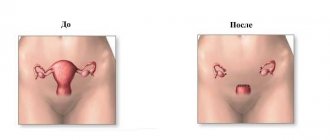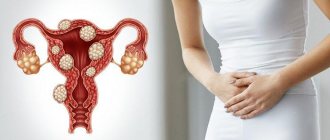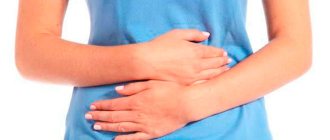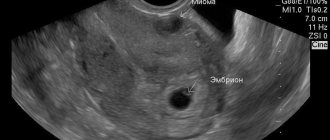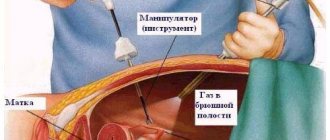Large fibroids
Fibroids are benign neoplasms that appear on the cervix. It is not deadly, but it grows quickly and its size compresses the organ.
Therefore, doctors insist on removing large fibroids. The key factor here is its size. If the fibroid reaches 6 cm or more, which is equal to 12 weeks of pregnancy, then such a tumor must be removed.
Doctors may also decide to remove fibroids that have not reached large or gigantic sizes for the following reasons:
- high probability of transformation of a benign neoplasm into a malignant one;
- the process of defecation and urination is disrupted;
- the tumor compresses nearby organs;
- the appearance of necrosis of neoplasm nodes;
- the appearance of a fibroid stalk;
- the likelihood of infertility or miscarriage.
The main reason will be the presence of large or gigantic sizes.
Order of conduct
There are various techniques for performing laparoscopic myomectomy, the choice of which depends on the number of myomatous nodes, their location, age and medical history of the patient.
During the intervention on the abdominal wall, the specialist makes punctures in the skin. Then he inserts a laparoscope with a video camera and other necessary instruments into them. The doctor monitors the progress of the operation using a large monitor.
A characteristic feature of these tumors is the presence of capsules around them. Therefore, technically, the intervention is a careful “husking” of nodes from the uterine tissue with simultaneous coagulation of bleeding areas. After this, the doctor sutured the walls with a self-absorbing thread, layer-by-layer comparison of all muscle layers.
After the procedure, the patient requires dynamic monitoring by a gynecologist and regular ultrasound scans. ON CLINIC specialists provide their patients with such control, if necessary, involving related specialists.
Planning pregnancy is recommended six months to a year after surgery.
Symptoms
Rarely, a woman may discover fibroids. This mainly happens during examination. There are some symptoms that may indirectly indicate its presence:
- changes in the menstrual cycle, accompanied by severe pain;
- constant nagging pain in the lower abdomen;
- painful sensations during physical intimacy, as well as bleeding after it;
- enlarged belly as during pregnancy;
- frequent and difficult urination.
Even if there is minor pain or suspicious discharge, a woman needs to visit a doctor.
It will take several years for fibroids to reach large or gigantic sizes. There have rarely been cases where a tumor grew in a matter of months.
If the tumor grows at a high rate, this may indicate the presence of malignant cells in it.
Causes
The main and main cause of this pathology is hormonal imbalance or a surge in hormonal levels. This disease can be inherited, therefore, if a woman has had similar cases in her family, it is necessary to more carefully examine her health.
Large fibroids can appear in those women who have abused abortions, who have had a large number of births, and also those suffering from diabetes.
Therapeutic fasting for fibroids
Indicated only for high cholesterol levels and obesity. In the case of fibroids, the purpose of fasting is solely to reduce body weight if you are overweight, which can help normalize hormonal levels. There are no independent scientific studies convincingly confirming other therapeutic effects of fasting on myomatous lesions. Before starting fasting, you need to seek advice (from a therapist, gynecologist, nutritionist), since the wrong “entry” can cause serious harm and only aggravate the condition.
IMPORTANT!!! It is strictly forbidden to start fasting on your own.
Childbirth with large fibroids
If you have large fibroids, it is often difficult for a woman to get pregnant. When the size of the tumor reaches 12 cm, it compresses the cervix and conception cannot occur.
If a woman becomes pregnant and an examination reveals this pathology, doctors try to maintain the pregnancy if possible. The patient is under constant observation.
Many pregnant women who received this diagnosis gave birth to healthy and healthy babies.
Delivery takes place for the most part by caesarean section. This reduces the risk of severe bleeding. In the presence of small fibroids, natural childbirth may be allowed, provided that the fibroids have not increased during pregnancy, but rather have decreased.
For reference: depending on the professionalism of the doctor, during childbirth by cesarean section, large fibroids can be removed.
Doctors mainly remove and treat fibroids after a woman gives birth.
List of used literature:
- “Embolization of the uterine arteries in the treatment of uterine fibroids”, Russian Medical Journal, 2006, No. 2, pp. 23-25, (co-authors Yu.E. Dobrokhotova, S.A. Kapranov, B.Yu. Bobrov, A.A. Alieva, I.I. Grishin).
- “Embolization of the uterine arteries - as a method of treating uterine fibroids,” in the book. Obstetrics and gynecology: modernity and traditions (edited by Yu.E. Dobrokhotova), Moscow, 2008, pp. 5-11) (co-authors A.A. Alieva, N.A. Litvinova, D.M. Magomedov, I .I.Grishin, O.I.Kauseva, S.A.Kapranov, Yu.E.Dobrokhotova).
- “The effectiveness and economic costs of using uterine artery embolization in patients with submucous uterine fibroids”, Russian Bulletin of Obstetrician-Gynecologist, 2008, vol. 7, no. 4, pp. 71-77, (co-authored by V.G. Breusenko, O.I. Mishieva, G.N. Golukhov, S.A. Kapranov, I.A. Krasnova).
- “Embolization of the uterine arteries in the complex treatment of cervical pregnancy,” in the book. Obstetrics and gynecology: modernity and traditions (edited by Yu.E. Dobrokhotova), Moscow, 2008, pp. 46-51) (co-authors I.I. Grishin, S.A. Kapranov, T.A. Chernyshenko, N N.Ivko, A.A.Alieva, O.I.Kauseva, B.Yu.Bobrov, I.I.Vityazeva, Yu.E.Dobrokhotova).
- “Uterine artery embolization (UAE) in obstetrics: pregnancy and childbirth after UAE for uterine fibroids. UAE - as a method of treating uterine bleeding in the postpartum period,” in the book. Obstetrics and gynecology: modernity and traditions (edited by Yu.E. Dobrokhotova), Moscow, 2008, pp. 121-124) (co-authored by E.M. Jobava, A.A. Aliyeva, S.A. Shinder, I I. Grishin, S. A. Kapranov, V. G. Krasnov, V. F. Ordynsky, O. F. Klekovkina, S. M. Sitkin, A. D. Podtetenev, Yu. E. Dobrokhotova).
Removal of fibroids using laparoscopy
Removing fibroids by laparoscopy does not involve a complete incision in the abdominal cavity, but only three small punctures. A camera is inserted into these holes, allowing the doctor to see the internal organs. Instruments are inserted into the other two holes, with the help of which the myomatous nodes are removed.
This type of operation has most positive aspects:
- there are no big and ugly scars left;
- The postoperative recovery period passes faster;
- low percentage of adhesion formation;
- a woman can get up the very next day after the intervention;
- mild or moderate pain after the procedure;
- low blood loss.
The downside is that the doctor who performed this type of surgery must be highly professional. The slightest movement of the hand or unprofessionalism can lead to bleeding, which will be quite difficult to stop.
For reference: A woman who has undergone this operation should not become pregnant for a year to avoid rupture of the sutures.
When prescribing laparoscopy, the doctor pays attention to several points that exclude this type of surgical intervention: the presence of abdominal operations, pregnancy, poor blood clotting, infections.
Contraindications
If there is an emergency need for surgical intervention, it is unacceptable only in case of a cold, accompanied by high fever and difficulty breathing. When performing a planned operation, there are the following contraindications:
- state of shock or coma;
- diseases of the heart and blood vessels;
- abdominal hernia;
- diaphragmatic hernia;
- poor blood clotting;
- respiratory system diseases;
- exhaustion of the body;
- presence of infection in the body;
- boils on the skin in the abdominal area;
- various dermatitis;
- exacerbation of chronic kidney and liver disease;
The presence of any of the listed factors requires cancellation or rescheduling of the operation until the patient’s condition improves. The specialist will prescribe surgical intervention only if health indicators are satisfactory. Neglect of them can cause serious complications.
Removal of fibroids using abdominal surgery
Abdominal fibroid surgery is performed if the tumor has reached gigantic or very large sizes. And also when cancer cells are detected in the formation.
If there are a lot of myomatous nodes and the fibroids are large, then sometimes it is necessary to completely remove the entire organ.
Surgery involves cutting into the abdominal cavity and manipulating the diseased organ. Sometimes it is partially removed, but in most cases, if the nodes are very widespread and large in shape, the organ is removed completely along with the cervix.
For women whose age has reached 55 years, and if this type of pathology is detected, the uterus is removed in most cases to prevent relapses. Only a woman of childbearing age will undergo all manipulations only to leave the uterus intact, if possible.
Hysterectomy (abdominal surgery) is performed only if there is no healthy tissue in the uterus and no other treatment method will work!
The postoperative period for the patient is much more difficult than after laparoscopy. Rehabilitation lasts from several weeks to several months, depending on the complexity of the disease.
What foods should you avoid?
For rapid rehabilitation after abdominal surgery, foods that can cause flatulence are first excluded from the diet.
In the first time after surgery, you should exclude:
| whole milk | sweet | Carbonated drinks |
The first days after surgery are especially important. At this time, they try to make the diet as gentle as possible. Nutrition during this period should be structured so that the body receives the largest amount of essential nutrients that are easily and quickly absorbed.
Gradually, nutrition after surgery becomes less and less sparing. The patient is transferred from liquid and pureed food to normal food. This will make it possible to reduce the stress caused to the body by surgery and allow it to quickly return to normal.
We should also not forget that most patients after such operations are not able to move independently in the first days. Since the body's powers need to be activated for repair and healing, food must be both nutritious and easily digestible. The body's main strength and energy should be spent on restoration processes, and not on digesting heavy food.
In the first days after surgery, it is especially important to adhere to one of the basic nutritional rules:
- You need to eat little and often. Large amounts of food can make the digestive tract difficult to function.
- It is advisable that the volume of one meal does not exceed 200 grams.
The attending physician should give instructions regarding the volume of fluid required by the patient during the postoperative period. At the same time, it is strictly not recommended to increase the volume of liquid on your own, as this can cause tissue swelling.
Water can be drunk as soon as the patient comes out of anesthesia, but again, in a volume not exceeding that allowed by the doctor.
Treatment without surgery
Traditional medicine is always resorted to when trying to avoid surgical or drug intervention. To remove large fibroids, you can use herbal infusions. But proportions and consumption must be done with caution.
Celandine
Celandine is the most common plant in the fight against tumors. It is taken in the form of tinctures or decoctions. Used alone or in combination with other herbs:
- nettle;
- St. John's wort;
- mint;
- hawthorn.
The mixture of herbs is poured with boiling water and infused for about two days. Then take 50 ml. 2 times a day. The drug has a detrimental effect on the tumor and strengthens the immune system. The period of admission is no more than two months.
Cases of self-resorption of large fibroids
There are quite a few cases where fibroids resolved on their own. This mainly happens during menopause. Here the level of estrogen decreases and the tumor declines. It is their presence that affects the growth and development of fibroids.
Consequences of deletion
After removal there is no guarantee that the tumor will not form again. Even proper treatment does not provide a 100% cure for the disease. Also, the consequences of removing uterine fibroids can be:
- cardiac ischemia;
- organ removal;
- infertility;
- formation of breast cancer;
- scanty periods or their absence;
- susceptibility of the internal genital organs to various infections.
And if fibroids are left untreated or neglected, they can soon develop into a malignant neoplasm. Such cases are rare, but they are increasingly present in the practice of doctors.
Preparing for surgery
The surgical method of removing uterine fibroids requires preparatory procedures. The preparation is as follows:
- study of the clinical picture and medical history;
- study of a woman's age;
- general condition of the body;
- determining the size and location of the tumor;
- blood and urine tests;
- examination of scrapings from the uterus;
- testing for infections;
- colposcopic examination;
- hysteroscopic diagnosis;
- ultrasonography;
- if necessary, treatment of diseases of the cardiovascular system;
- hormonal therapy.
Direct preparation for hysterectomy surgery involves following hygiene procedures: taking a bath or shower and removing pubic hair. The day before, it is recommended to have a light dinner, preferably based on liquid food, then take sleeping pills in order to get enough sleep before surgical treatment measures.
Important! It is necessary to adhere to a light fasting diet a week before surgery. Eat fermented milk products, take sedatives and treat the genitals with antiseptics.
Also, in the evening before the operation, the intestines are cleansed using an enema. To use anesthesia, you must stop eating and drinking on the day of surgery. Sedatives are recommended in the morning.
For young women, the priority remains to perform surgery while preserving reproductive function. Women of older age undergo radical surgery, with complete removal of the uterus. The doctor makes an opinion, but the final choice of surgical treatment is made by the patient.
Diet and sports, prevention
Every woman should visit a gynecologist twice a year. Myoma, like many other diseases of the female genital organs, may not make itself felt at all in the initial stages. Only an ultrasound and examination can reveal the presence of any pathology, which can grow over time and bring undesirable consequences.
After removal and treatment of the tumor, the woman must follow the following instructions:
- The main thing a woman needs is proper nutrition and diet. After removal of fibroids, you should not strain, so bowel movements should be effortless. To do this, you need to eat foods rich in fiber, as well as foods that have a mild laxative effect. Such a diet leads to the fact that a woman begins to lose excess weight, which benefits the body as a whole.
- Those who are intensely involved in sports will have to postpone visiting the gym and lifting weights. The maximum weight that patients are allowed to lift is about 4 kg. During intense sports activities, the stitches may come apart, leading to bleeding and damage to the organ.
- Follow all the doctor’s recommendations: if you are prescribed to wear a bandage, wear it; if you are prescribed a course of hormonal medications, take medications. It is also necessary to attend physical procedures.
Important: As for intimate life, it can only be done 1-2 months after the operation. With physical proximity, the stitches may come apart, and infection may also occur.
A woman needs peace, fresh air and positive emotions. By complying with all the doctors’ requirements, the patient will quickly recover and there is a possibility that the disease will not return to her.
Recommendations
It is necessary to monitor the foods you eat in order to avoid constipation. Since they can put pressure on the uterine appendages and cause suture ruptures and inflammation of the appendages. Physical activity can also cause the seams to separate, and the incision made will take longer to heal.
If you have problems with urination, constipation or vaginal prolapse, Kegel exercises will help. The body is completely regenerated no earlier than after 4 months.
Following the recommendations and advice of your doctor will help you return to your normal lifestyle much faster. Carrying out preventive measures will help avoid serious complications and consequences. Many women note an improvement in their condition and quality of life after removal of fibroid tumors. Therefore, when a specialist prescribes an operation according to indications, you should overcome your fear and go for it.
If the article was useful to you, be sure to share it on social networks. And also leave your reviews and comments about what was written. Be sure to share your experience with site visitors. Thank you for your attention!
Women's stories about removal of large subserous fibroids
Irina, 30 years old: During the initial examination, I was diagnosed with a subserous node with a diameter of 5 cm, a year later it grew to 10 cm. The doctor said that both the node and the entire uterus needed to be removed. In a panic, I turned to another doctor, they said that the previous doctor had made a mistake in the sizes. As a result, a laparoscopy was performed to remove the nodes. And now everything is fine!
Ekaterina Ivanovna, 60 years old: during a routine examination, a tumor with a diameter of about 12 cm was discovered, and it was removed along with the uterus. Although I am not afraid of relapses of the disease, due to the removed organ, frequent health problems began.
Lisa, 26 years old: I had small fibroids (2 cm), but this did not stop me from getting pregnant. As the child grew, the tumor increased. She was under the supervision of doctors all the time. At 6 months the tumor suddenly stopped growing! Every month it became smaller and smaller. During the caesarean section, the one that was left was also removed. 5 years have passed and everything seems to be fine. I check regularly.
Video: large uterine fibroids
Large uterine fibroids (large myomatous node)
Video: large uterine fibroids with centripetal growth
Large uterine fibroids with centripetal growth.
Video: a woman had a large fibroid, her legs hurt, she couldn’t walk on her own
The woman had a large fibroid, her legs hurt, and she couldn’t walk.
Basic principles of nutrition for uterine fibroids
It has been proven that high-calorie, fatty foods increase cholesterol levels in the blood, provoke increased synthesis of progesterone (the main factor in the pathogenesis of the disease), enhance the deposition of adipose tissue and accelerate the synthesis of estrogen (which enhances the effect of progesterone). Accordingly, a diet for fibroids should exclude such foods. Fractional meals pursue the same goals.
Here is a list of foods that should be excluded from the diet as much as possible due to their ability to increase cholesterol levels:
- fatty, fried foods;
- confectionery products (sweets, cakes, pastries, sweet pastries);
- alcoholic drinks;
- smoked meats;
- sausages;
- fatty rich soups;
- butter;
- margarine.
For uterine fibroids, various juices are especially useful. They are not just recommended, but directly indicated for use. First of all, these are juices from fresh and frozen berries (high content of flavonoids and antioxidants).
Taking into account the benefits and harms of foods, excluding from the diet everything that cannot be eaten with fibroids, it is easy to create an approximate menu for every day.


